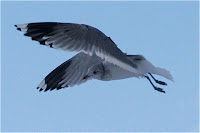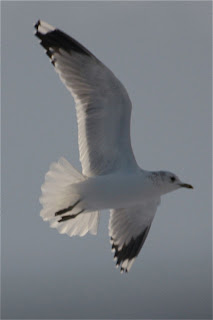Maybe the reason I have never looked too closely before is that much of the variation within the species is quite subtle, and really requires a DSLR to help pick out the differences. Of course, those who have looked at Common Gulls before have established that the separation of the regular UK form L. c. canus from the more eastern form L. c. heinei is fraught with difficulty due to overlap and intergrades. The latter almost certainly occurs in Scotland but a colour-ring record or in-the-hand measurements would be required to prove it. There are further species/subspecies further east (L. c. kamtschatschensis) and further west (L. c. brachyrynchus). That said, all of the below are likely to be straightforward, or rather not-so-straighforward, L. c. canus.
All photographs taken 30 November – 4 December 2010, Edinburgh, UK.
First winter (1CY)
Two images of the same bird – a fairly dark individual.
Underwing variation in two first-winter birds. The first bird was strikingly pale below. The second shows much more extensive dark fringes to the coverts and axillaries.
Upperwing variation in three first-winter birds. The first bird is the same as the first bird above and shows a fairly uniform upperwing. The following individuals show a paler grey greater covert bar across the wing and a black sub-terminal bar to the secondaries. Note the different extent of the subterminal arrowheads on the inner primaries and subterminal markings on the greater coverts in the two latter birds.
Tail
The extent of the subterminal band was different on the outer tail feather of these three first winter birds. Uppertail coverts are white, streaked or spotted here.
Second winter (2CY)
Second calendar year birds show varying amounts of black feathering on their lesser, median and greater upperwing coverts of their outerwing.
Adults
The adults show variation in wingtip pattern. The extent of black in the wing varies as does the extent of the white markings. These two birds show similar patterns although the left hand bird has a reduced black tip to its outermost primary (P10) and black subterminal markings reach to P6. The righthand bird has a narrow subterminal band on P5.
The difference between black subterminal markings can extending to P6 or to P5 can also be seen in these two birds. (Primary 10 is the outermost flight feather.)
Black subterminal markings can also extend as far as P4 as seen on this bird on the left compared to a bird in a similar pose with the black extending to P5.
Most adult birds have two white mirrors (in P10 and P9). Some birds also have a mirror in P8 as shown by this bird below. Here, the two mirrors on the outermost primaries combine to form a large white area and the mirror on P8 forms an isolated spot. This bird also shows large white moons – tongues of white between the grey of the wing and the black subterminal band. Compare the width of these moons with those of the birds above, which appear narrower. Notice also the neat black shafts of the primary flight feathers and the difference in the width of the terminal white tips of the secondaries (broad) and primaries (narrow). The latter is particularly noticeable on the righthand bird above.
Possible adults
For these birds I have no upperwing image so they may be adults or 2CY (second-winter) birds. However, I think that most are adults.
Notice again the extent of black subterminal markings – to P5 (giving a longer black trailing edge) and P6 (a shorter trainling edge). The extent of black on the tip of P10 also differs. Also notice the different extent of the white tongues eating into the black colour of the wing. The righthand bird has a similar length of tongue on both P7 and P8, whereas the lefthand bird has a longer tongue on P7 giving a more triangular shape to the black on the wingtip.
The following two birds have a similar pattern, with the black extending to only P6. Note that the lefthand bird has an almost complete white tip to P10, which may indicate that it is a male.
On the lefthand bird below note that there appears to be a tiny white mirror in P8 and that there is a hint of a black subterminal mark on P4. The righthand bird has a much blacker wingtip with much more extensive black on P8 – maybe it is not an adult bird, but a 2nd calendar year bird (2CY) instead, an idea that would be supported by the reduced white wingtip markings on P8–6.

The following birds show more extensive white tongues on P8 to the point where the tongue is approaching the white mirror of p9.
Well, if you are still reading, you probably like Common Gulls, so here is one last picture of an adult. Not an easy view to get in this back garden, so I think I'll have to go elsewhere to get more shots of perched birds...





























No comments:
Post a Comment